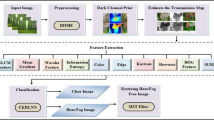Abstract
Outdoor images taken in inclement weather conditions are often contaminated with colloidal particles and droplet in the atmosphere. These captured images are susceptible to low contrast, poor visibility, and color distortion, which is the reason for serious errors in digital image vision systems. Therefore, defogging research has material significance for practical applications. In this paper, image dehazing is regarded as a mathematical inversion and image restoration process on the basis of fog image degradation model. The global atmospheric light A can be approximately estimated by combining Gaussian low-pass filtering with the single-threshold segmentation and binary tree method. And a deep learning transmittance network is adopted to modify transmittance. Comparison experimental results show that our method is effective in dealing with thick fog, complex scenes and multicolor images. In addition, our method is superior to four other state-of-the-art defogging methods in visual impact, universality and running speed.
Graphic abstract
The overall framework of our method










Similar content being viewed by others
References
Narasimhan, S.G., Nayar, S.K.: Chromatic framework for vision in bad weather. In: Proceedings of the IEEE CVPR00, pp. 598–605. IEEE Computer Society, Washington (2000)
Ru, Y., Tanaka, G.: Proposal of multiscale retinex using illumination adjustment for digital images. Ieice Trans. Fundam. Electron. Commun. Comput. Sci. E99(11), 2003–2007 (2016)
Raffei, A.M., Asmuni, H., Hassan, R., Othman, R.M.: A low lighting or contrast ratio visible iris recognition using iso-contrast limited adaptive histogram equalization. Knowl. Based Syst. 74(1), 40–48 (2015)
Wang, Z., Feng, Y.: Fast single haze image enhancement. Comput. Electr. Eng. 40(3), 785–795 (2014)
Babu, P., Rajamani, V.: Contrast enhancement using real coded genetic algorithm based modified histogram equalization for gray scale images. Int. J. Imaging Syst. Technol. 25(1), 24–32 (2015)
Dippel, S., Stahl, M., Wiemker, R., Blaffert, T.: Multiscale contrast enhancement for radiographies: Laplacian pyramid versus fast wavelet transform. IEEE Trans. Med. Imaging 21(4), 343–353 (2002)
Seow, M.J., Asari, V.K.: Ratio rule and homomorphic filter for enhancement of digital colour image. Neurocomputing 69(7), 954–958 (2006)
Sulami, M., Glatzer, I., Fattal, R., Werman, M.: Automatic recovery of the atmospheric light in hazy images. In: IEEE International Conference on Computational Photography, pp. 1–11 (2014)
Fattal, R.: Single image dehazing. ACM Trans. Graph. 27(3), 1–9 (2008)
He, K., Sun, J., Tang, X.O.: Single image haze removal using dark channel prior. In: Proceedings of the IEEE CVPR09, pp. 1956–1963. IEEE Computer Society, Washington (2009)
He, K., Sun, J., Tang, X.: Guided image filtering. IEEE Trans. Pattern Anal. Mach. Intell. 35(6), 1397–1409 (2013)
Fu, H., Wu, B., Shao, Y., Zhang, H.: Perception oriented haze image definition restoration by basing on physical optics model. IEEE Photonics J. 10(3), 1–16 (2018)
Fu, H., Wu, B., Zhang, H.: De-hazing of atmosphere veil haze image. Opt. Precis. Eng. 24(8), 2018–2026 (2016)
Li, J., Li, G., Fan, H.: Image dehazing using residual-based deep CNN. IEEE Access. 6, 26831–26842 (2015)
Ren, W., Liu, S., Zhang, H., Pan, J., Cao, X., Yang, M.H.: Single Image Dehazing via Multi-scale Convolutional Neural Networks. In: European Conference on Computer Vision, pp. 154–169 (2016)
Koschmider, H.: Theorie der horizontalen sichtweite Contrib. Beitr. Phys. Freien Atmos. 12, 171–181 (1924)
Li, Z., Zheng, J.: Edge-preserving decomposition based single image haze removal. IEEE Trans. Image Process. 24(12), 5432–5441 (2015)
Seonhee, P., Soohwan, Y., Minseo, K., Kwanwoo, P., Joonki, P.: Dual autoencoder network for retinex-based low-light image enhancement. IEEE Access 6, 22084–22093 (2018)
Fu, H., Wu, B., Shao, Y., Zhang, H.: Scene-awareness based single image Dehazing technique via automatic estimation of sky area. IEEE Access 7, 1829–1839 (2019)
Fu, H., Wu, B., Zhang, H., Xu, J.: Fast image dehazing based on dark-Chanel physical model. Opto-Electron. Eng. 2, 82–88 (2016)
Veelaert, P.: Image segmentation with adaptive region growing based on a polynomial surface model. J. Electron. Imaging 22(4), 3004 (2013)
Ancuti, C.O., Ancuti, C., Hermans, C., Philippe, B.: A fast semi-inverse approach to detect and remove the haze from a single image. In: 2010-10th Asian Conference on Computer Vision. Queenstown (ACCV), pp. 501–514(2010)
Cai, B., Xu, X., Jia, K., Qing, C., Tao, D.: DehazeNet: an end-to-end system for single image haze removal. IEEE Trans. Image Process. 25(11), 5187–5198 (2016)
Li, X.: Preconditioned stochastic gradient descent. IEEE Trans. Neural Netw. Learn. Syst. 29(5), 1454–1466 (2018)
Wang, K., Wang, H., Li, Y., Hu, Y., Li, Y.: Quantitative performance evaluation for Dehazing algorithms on synthetic outdoor hazy images. IEEE Access 6(99), 20481–20496 (2018)
Wang, W., Yuan, X., Wu, X., Liu, Y.: Fast image dehazing method based on linear transformation. IEEE Trans. Multimed. 19(6), 1142–1154 (2017)
Luan, Z., Shang, Y., Zhou, X., Shao, Z., Guo, D., Liu, X.: Fast single image dehazing based on a regression model. Neurocomputing 245, 10–22 (2017)
Hautiere, N., Tarel, J.P., Aubert, D.: Blind contrast enhancement assessment by gradient ratioing at visible edges. Image Anal. Stereol. 27(2), 87–95 (2011)
Ju, M., Gu, Z., Zhang, D.: Single image haze removal based on the improved atmospheric scattering model. Neurocomputing 260, 180–191 (2017)
Author information
Authors and Affiliations
Corresponding author
Additional information
Publisher's Note
Springer Nature remains neutral with regard to jurisdictional claims in published maps and institutional affiliations.
Rights and permissions
About this article
Cite this article
Li, B., Zhao, J. & Fu, H. DLT-Net: deep learning transmittance network for single image haze removal. SIViP 14, 1245–1253 (2020). https://doi.org/10.1007/s11760-020-01665-9
Received:
Revised:
Accepted:
Published:
Issue Date:
DOI: https://doi.org/10.1007/s11760-020-01665-9




